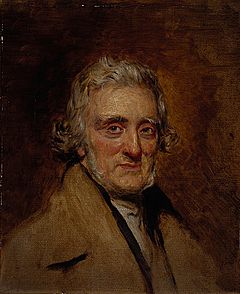John Henning (1771–1851) facts for kids
Quick facts for kids
John Henning
|
|
|---|---|

John Henning by Robert Scott Lauder
|
|
| Born | 1771 |
| Died | 1851 |
| Nationality | Scottish |
| Education | self-taught |
| Spouse(s) | Catherine Sunter |
| Children | five |
John Henning (born May 2, 1771 – died April 8, 1851) was a talented Scottish sculptor. He started his career as a carpenter. His most famous works were tiny models of ancient Greek sculptures. These included parts of the Parthenon and Bassae friezes.
These amazing models were one-twentieth the original size. It took him twelve years to finish them. Many people copied his ideas later. However, he could not stop them. This was because he couldn't copyright art made by artists who lived long ago.
Contents
John Henning's Life Story
Henning was born in Paisley, Scotland. His father, Samuel Henning, was a carpenter and builder. John learned how to carve wood from his dad.
Early Artworks and Success
John became known for his sculpting skills. He made small, detailed carvings called cameos. These were often portraits of his friends and family. When he was 28, he married Catherine Sunter. She encouraged him to start his own business.
He opened his business first in Glasgow, then in Edinburgh. Important people like Sir Walter Scott became his clients. Josiah Wedgwood, a famous pottery maker, was also impressed. He agreed to help Henning promote his work. In 1810, Henning was listed as a "portrait modeller." He lived in Edinburgh's First New Town.
Moving to London and the Elgin Marbles
In 1811, John and Catherine moved to London. There, Henning saw the famous Elgin Marbles. These ancient Greek sculptures had just arrived in England. They were kept at Burlington House. Henning convinced Lord Elgin to let him draw and copy them.
A special request from Princess Charlotte gave Henning an idea. She asked him to make a portrait medallion. This made him realize he could use his drawings to create small copies of the friezes. He made molds from slate to do this.
Creating Miniature Friezes
This huge project took him twelve years. Henning decided to also include the Bassae frieze in his work. This frieze arrived in England a few years after he started. One tiny version of the Parthenon frieze was only two inches tall. But it was over twenty-four feet long!
By 1820, Henning was ready to sell his work. It was clear he hadn't just copied the damaged sculptures. He had recreated them. For the Parthenon frieze, he used old drawings. These included drawings by William Pars (from 1765) and Feodor Ivanowitsch. He also used drawings by Jacques Carrey. Carrey's drawings were made in 1674. This was thirteen years before an explosion damaged the Parthenon in 1687.
Copyright Challenges
One miniature Parthenon frieze was sold to William IV for £42 in 1821. Its current location is unknown. Henning could not get a copyright for his work. This meant others made copies and earned money from his ideas. Very few original copies of his miniatures still exist today.
Later Projects and Legacy
In 1827, Henning and his son made sculptures. They were in the style of the Parthenon frieze. These were for a screen at Hyde Park Gate in London. The next year, his son, John Jr., agreed to make a copy of the Parthenon frieze. This was for London's Athenaeum Club.
This model was the correct size, though shorter than the original. It was made from Bath stone. Henning also made half-scale models. He hoped to sell these for smaller buildings. They became very popular. However, others across Europe made unauthorized copies. This was very upsetting to Henning. He also disliked the poor quality of some copies. Because of this, Henning supported new laws on copyright. He was sad that his hard work wasn't fully rewarded.
In 1845, Henning started another project. He planned to create engravings of the two friezes. Test prints were made. Sadly, his business partner, Alfred Robert Freebairn (1794–1846), died. The works were never finished.
John Henning died on April 8, 1851. This was two years after his wife passed away. He was buried in Finchley Churchyard.
What John Henning Left Behind
Henning's original slate models are now at the British Museum. They were bought in 1938. The Athenaeum Club and the screen at Hyde Park still exist today. Copies of Henning's amazing work are still being found.
John Henning's Family
John Henning's oldest son, John Henning (1801-1857), was also a sculptor. He won an award for his relief called "The Good Samaritan." In 1825, he helped fix the statue of Queen Anne. This statue is in front of St Paul's Cathedral. In 1836, he created the figures on the front of Manchester Art Gallery.
Another son, Samuel Henning (c.1802-1832), helped his father. He worked on restoring the Elgin Marbles. He also designed the tomb of Duncan Sinclair. This tomb is in Kensal Green Cemetery. Samuel died from cholera in 1832.
His son Archibald Skirving Henning became an artist. Some of his paintings are in public collections in the United Kingdom. Archibald died in Manchester in 1864, at age 59. He was named after the Scottish artist Archibald Skirving.

